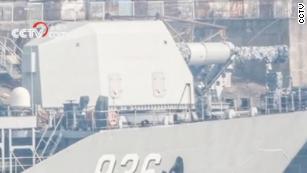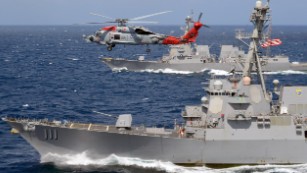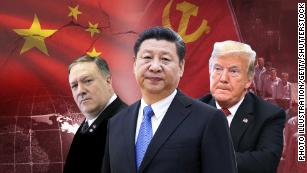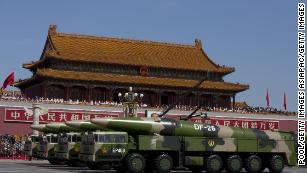China's military is going from strength to strength under Xi Jinping
Under Chinese President Xi Jinping, a revolution has been taking place inside Beijing's armed forces.
The People's Liberation Army (PLA) has grown and modernized rapidly since China reopened to the world in the 1980s, but under Xi that pace has accelerated with a focus on fighting and winning future wars.
Xi has also embarked on a massive internal reorganization of the PLA, streamlining the organization and bringing it firmly under his control.
On Tuesday, the Chinese government unveiled an increase in military spending of 7.5% during its annual "Two Sessions" legislative meeting in Beijing, a slight dip on last year's spending increase.
Experts said the slight drop was likely to avoid domestic perceptions that the country's military spending far exceeded its overall economic growth, which is set to grow at no more than 6.5% in 2019.
While the Chinese military may be one of the world's best-funded armed forces, its budget still pales in comparison to United States. In December, US President Donald Trump agreed to increase the defense budget funding to $750 billion in 2019.
The US Navy still dominates the world's oceans too, far outpacing China in its logistical capabilities and international reach.
But Beijing is rapidly gaining ground on its American rival, by churning out naval vessels and making technological advances, according to Andrew Erickson, professor of strategy at the US Naval War College's China Maritime Studies Institute.
"No one has presided over this level of Chinese military development in Chinese history before Xi Jinping," he said.
'Armed forces to be reckoned with'
Directly comparing every aspect of two countries' military budgets is impossible, said Erickson, because different governments count spending in different ways.
But the US expert said it was incontrovertible that China's military budget was the second largest in the world.
"Clearly, overall, these are armed forces to be reckoned with. In many areas, they have weapons systems that only a few other countries possess," he said.
China closer to equipping warships with electromagnetic railguns, state media reports
"If you look where China's military was a few short years ago, under Xi the progress is truly tremendous. It is very impressive."
The signs of a push to modernize the military are everywhere. Between 2016 and 2017, 32 new shipswere commissioned by the PLA, according to US government reports. In comparison, the US commissioned 13.
Since 2014, China has launched more submarines, warships, principal amphibious vessels and auxiliaries than the total number of ships currently serving in the navies of Germany, India, Spain, Taiwan and the United Kingdom, according to a 2018 report by think tank IISS.
"China's navy is receiving warships so quickly that Chinese sources liken this to dumping dumplings into soup broth," Erickson said.
The Chinese air force has also been regularly debuting new and improved planes and weapons, including the twin-engine J-20 stealth fighter.
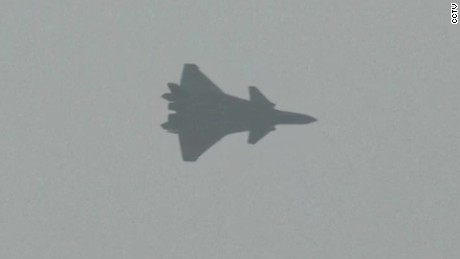
China shows off new J-20 stealth fighter (2016)
Beijing's air force is now the largest in Asia and the third largest in the world, according to the US Defense Department, and is closing the gap with the US "across a spectrum of capabilities."
At the same time, Xi has also begun a reorganization of military personnel, stressing quality and effectiveness over quantity of staff. In 2017, Xi streamlined the powerful Central Military Commission, which he leads, reducing the number of members and solidifying his control.
Multiple former generals have been disciplined or imprisoned for corruption in an attempt to professionalize the armed services.
Aircraft carriers and corvettes
While the military strengths of the US and China are often compared, the two governments ostensibly have built their armed forces to serve different goals.
Washington says it aims to maintain a worldwide reach for its military to protect allies and American interests internationally.
Beijing claims its interests lie closer to home.
US warships again challenge Beijing's claims in South China Sea
Zhang Yesui, the National People's Congress spokesman, on Monday afternoon told reporters: "China's limited defense spending, which is for safeguarding its national sovereignty, security and territorial integrity, poses no threat to any other country.
"Whether a country is a military threat to others or not is not determined by its increase in defense expenditure, but by the foreign and national defense policies it adopts."
The major scenarios that China's military cares about could be called "home games, rather than away games," Erickson said.
The Chinese government has built a navy and armed forces designed to protect the country and exert its influence in the surrounding region, especially the East and South China seas.
The proof is in the military hardware that the two countries have focused on.
While the US has a huge fleet of 12 nuclear-powered aircraft carriers, China has barely one conventionally powered carrier operating, with another in the wings. The Type 001A, the country's first homegrown aircraft carrier, was launched in 2018 but still has not joined the fleet.
Xi Jinping's global dreams hit a wall amid growing backlash against China
Beijing has, however, rapidly produced Jiangdao-class corvettes, a small warship generally best suited to fighting close to home. A US Department of Defense report in 2018 said this move was designed with an eye to "littoral" combat, or fighting close to China's shores.
Backing this up is China's rapid production of frigates, another small type of warship, and the arming and expansion of the country's coast guard.
This makes sense given the Chinese government's focus on controlling the South China Sea, where it has been building militarized artificial islands and holding regular drills in the sea.
But all this doesn't prevent the Chinese military from having growing its fleet to extend its global influence. The PLA opened its first international base in Djibouti in July 2017. A third aircraft carrier is reportedly under construction, featuring advanced launching capabilities.
"They're building power projection capabilities which will give them greater ability to project presence and power (into) the Pacific and the Indian Ocean," said Malcolm Davis, senior analyst at the Australian Strategic Policy Institute.
Doubts
China has undoubtedly made rapid progress. Some experts, however, doubt its ability to fight as a coherent force or the experience of its troops.
There are also doubts around the effectiveness of some of the PLA's new technologies. Military analyst Carl Schuster, a former US Navy captain, has cast doubt on some of the advances allegedly made by the Chinese military, including claims that it has developed a ship-killer ballistic missile.
Is China's latest weaponry science fiction or battle ready?
Such a missile could in theory be based well out-of-range of US naval strike forces while putting Washington's biggest assets, its aircraft carriers, in range.
But Schuster says no military has ever successfully developed an anti-ship ballistic missile and China had shown no evidence of actually being able to hit a moving target in the ocean.
There is also discontent within the Chinese military over the treatment of veterans. The decision in 2015 to lay off 300,000 soldiers over three years to streamline the armed forces led to repeated mass protests in a number of cities after the government failed to pay all their pensions in full.
But Davis said the military prospects of the United States are looking increasingly troubled, thanks to rising maintenance costs and an aging fleet, which might give Beijing the chance it needs to catch up.
"It's not clear the traditional advantage in military technology for the US is going to remain intact," he said.
"Getting that balance between sustainment and modernization right is a real challenge for the US as their forces get older and older, whereas the Chinese are steamrolling ahead."
News Courtesy: www.cnn.com


